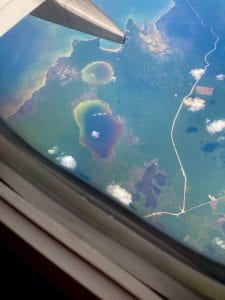Well, we left Glover’s reef this morning and now I’m back in Houston.
As I look back on my time in Belize, I can’t help but marvel at how the tropical rainforest and coral reef each tell their own story, yet share so many similarities. Both are vibrant ecosystems teeming with life, where every inch seems to host something new and surprising. Whether it was towering trees covered in epiphytes or coral heads bursting with schools of fish, these places had layers upon layers of life that created an overwhelming sense of wonder.
One thing that really struck me is how both the rainforest and reef are built in three dimensions. In the rainforest, I saw how even a single tree could be home to ants, epiphytes, and hidden birds’ nests, all stacked together in this complex network. The reef felt the same way, with fish weaving between corals and sea fans swaying with the current. All of this structure gives room for so many different species to coexist, which I think is a big reason why they’re both so incredibly diverse.
Of course, there were some big differences too. The rainforest felt dark and mysterious, with all sorts of insects crawling around on the forest floor. The reef was much brighter and more colorful, with fish flashing by and rays of sunlight piercing the water. The rainforest almost felt ancient and hushed, like a hidden cathedral, while the reef seemed alive with constant motion and sound.
When I first signed up for this course, I knew I’d be learning a lot about these ecosystems, but I didn’t realize how much of it would come from actually being out in the field. I loved being able to see everything up close and hear about the unique ways plants and animals interact. My absolute favorite moment was the day we explored the ATM caves. The crystal-clear water, the towering ceilings, and the human history woven into that space made it feel completely surreal. It was something I’ll never forget. On the other hand, I could have done without the cockroach invasion that first night at Las Cuevas! Finding them in my pillow was definitely a low point, but it gave me a whole new appreciation for how adaptable those little creatures are.
Three things really stand out that I know I’ll remember for years. First, I was amazed to learn that even though the rainforest is so green and lush, the soil itself isn’t rich in nutrients. The nutrients are mostly in the plants and animals themselves, and as things break down, they’re recycled really quickly back into the ecosystem. Second, seeing how mutualistic relationships work in both the rainforest and the reef was eye-opening. Whether it was ants defending cecropia trees or coral polyps sheltering algae, it was so cool to see how cooperation really drives these ecosystems forward. Lastly, hearing Rafael Manzanero from FCD talk about conservation challenges made me realize how complicated it all is. It’s not just about protecting animals or trees, but about balancing people’s livelihoods and the forest itself. It got me thinking about environmental law and how real conservation work has to include everyone.
This trip taught me to embrace both the awesome and the uncomfortable moments. I’ll never forget seeing a puma in our camera trap photos, swimming alongside parrotfish on the reef, or watching the sun go down from the bird tower in the rainforest. Five years from now, I’m sure I’ll still be thinking about the night we caught a squid off the dock and the quiet moment in the rainforest when it hit me just how alive everything really is. I’m so grateful for every day of this experience, even the ones with cockroaches in my bed.
(Photos taken by Scott Solomon)
-Emily































